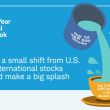by Gerald du Manoir, Samir Parekh, Steve Caruthers, Capital Group
For the first time in many years, the picture is brightening for international stocks. There are new catalysts accelerating change: fiscal stimulus in Germany, corporate reforms in Japan and South Korea, a weakening U.S. dollar, signs of stabilization in China, and an improving policy environment in Europe.
Non-U.S. stocks have had a bright start to the year, pacing global markets through the first four months of 2025. The MSCI Europe, MSCI EAFE and MSCI ACWI ex USA indices have all notched solid gains amid a sharp decline for the S&P 500 Index.
“Since the April 2 tariff announcement, U.S. and non-U.S. stocks have been highly correlated, which is what one would expect in a period of heightened market volatility,” says Samir Parekh, portfolio manager for Capital Group International Equity Fund™ (Canada) and Capital Group International Equity Select™ ETF (Canada). “Once the dust settles, the setup for international stocks looks constructive. Starting valuations are much lower relative to the U.S. Many international companies have domestic businesses not exposed to U.S. policy disruption, and corporate governance is improving in certain regions.”
And in currency markets, movements suggest the possibility of slower U.S. growth, a more accommodating U.S. Federal Reserve and lower real interest rates. The U.S. dollar appears less attractive, as the differential in real (inflation-adjusted) rates between the U.S. and other countries has shrunk.
International stocks have taken the lead

Sources: MSCI, RIMES, S&P Global. Data as of April 30, 2025.
German stimulus sets new tone for Europe
In Europe, it’s billed as the “whatever it takes” moment. Member states of the European Union are focused on economic revitalization, in light of a report on competitiveness by economist and former Italian Prime Minister Mario Draghi, as well as increasing trade tensions with major trading partners, such as the U.S. and China.
Germany, Europe’s largest economy and often known for its austerity, announced a large fiscal stimulus in March, one of the most significant policy changes since the reunification of East and West Germany in 1990. There’s also a sense that the regulatory environment may become more pro-investment and open to change.
“I’m relatively optimistic,” says Gerald Du Manoir, also a portfolio manager for Capital Group International Equity Fund™ (Canada) and Capital Group International Equity Select™ ETF (Canada). “Stimulus from Germany will benefit Europe, and we could see a stronger industrial cycle over the next three years. That said, it’s going to take time for stimulus to be implemented and work its way through economies.”
German stocks closely correlated to manufacturing

Sources: FactSet, S&P Global. Data from June 1, 2007, to May 8, 2025. The DAX Index rolling one-year total shareholder return (TSR) is as of May 8, 2025. German manufacturing purchasers managing index (PMI) as April 30, 2025.
European commercial banks, which have become more profitable and amassed significant capital reserves, are poised to benefit from government spending, as well as companies related to defence, building materials and infrastructure. A pool of attractive companies — European insurers, telecom operators and utility providers, for example — are seen as resilient, dividend-paying stocks with minimal tariff exposure. Some may benefit if the euro gains further strength against the dollar.
“There is a greater recognition in Europe that they need to be self-sufficient,” Parekh says. “The fact that Europe is focused on supporting their economy in the face of what they see as adversarial U.S. policy is likely to have positive ramifications for many companies.”
It may take until 2026 to see a meaningful growth pickup in Europe, given the near-term impact of tariff uncertainty. Plus, execution remains in doubt under new German Chancellor Friedrich Merz. He initially faced difficulty securing votes, which may be a setback as he seeks to gain wider consensus within Germany and from other European countries pushing for faster reforms.
Japan could get boost from trade and corporate reforms
Japan could benefit from shifting trade alliances. The country’s average tariff rate remains among the world’s lowest, highlighting the potential for productive negotiations amid rising trade war fears.
In recent years, Japan has emerged as a free trade powerhouse, with agreements such as JEFTA, TPP and RCEP. It struck trade and digital agreements with the U.S. during the first Trump administration and continues to collaborate in areas like 5G networks, space exploration and medical research.
Japan is also undergoing a corporate governance revival. Reforms around profitability still have a way to go and have helped drive robust returns for the MSCI Japan Index since 2023.
Similarly, South Korea is in the early innings of adapting Japan’s playbook. It wants companies to focus on boosting their return on equity and book value. Potential outcomes could include larger dividends, share buybacks and asset divestitures.
Japanese firms have accelerated stock buybacks

Source: Goldman Sachs. Data as of December 31, 2024. JPY: Japanese yen.
China may bolster its economy with stimulus
To counter high U.S. tariffs, China’s leaders may enact stronger stimulus measures, which might indirectly benefit Europe, one of its largest trading partners. China’s export-led economy is likely to be challenged by the new rates, especially if its manufacturers saturate other markets with formerly U.S.-bound goods.
Larger stimulus might create a favourable environment for domestic-focused companies that could benefit from the country’s huge consumer savings stockpile.
Importantly, China’s policy is pivoting in a more positive direction for its entrepreneurial economy. Top officials, seeking to capitalize on the global splash of DeepSeek and its AI training model, have become more vocal in their support of companies in technology and electric vehicles. For instance, in February China’s President Xi Jinping and top party leaders hosted a rare meeting with the country’s most prominent entrepreneurs.
China's tech leaders outpace the Magnificent Seven

Source: FactSet. Mag Seven: Alphabet, Amazon, Apple, Meta, Microsoft, Nvidia, Tesla. China innovation leaders: Alibaba, BYD, JD.com, Meituan, NetEase, PDD-US, Trip.com. Data from December 31, 2024, to April 28, 2025.
Valuations remain attractive
Over the last few years, cheaper valuations compared to similar U.S. businesses have been the main argument in favour of international equities. But new catalysts are changing the narrative for the first time in years. Moreover, in an environment where infrastructure spending rises, non-U.S. markets are more diverse and weighted higher in heavy industry, energy, materials and chemicals than the S&P 500.
The MSCI ACWI ex USA trades at 13 times earnings on a 12-month forward basis, while the MSCI EAFE (developed international) trades at 14 times — both near their 10-year averages and at a substantial discount to the S&P 500, which trades at 20 times earnings.
International stocks trade near 20-year low relative to U.S.

Sources: Capital Group, FactSet, MSCI. As of March 31, 2025. NTM = next twelve months. P/E = price-to-earnings.
Of course, non-U.S. stocks have long been inexpensive for a reason. Earnings growth has been anemic compared to the U.S. and its vibrant technology sector over the past decade. If earnings growth rebounds across international markets, price-to-earnings ratios could rerate higher.
Gerald Du Manoir is an equity portfolio manager with 34 years of investment industry experience (as of 12/31/2024). He holds a degree in international finance from the Institut Supérieur de Gestion in Paris.
Samir Parekh is an equity portfolio manager and a global research coordinator with 23 years of investment industry experience (as of 12/31/2024). He holds a post-graduate diploma in business administration (equivalent to an MBA) from the Indian Institute of Management, Ahmedabad, and a bachelor’s degree from Sydenham College, Bombay University. He also holds the Chartered Financial Analyst® designation.
Steve Caruthers is an equity investment director with 30 years of investment industry experience (as of 12/31/2024). He has an MBA from the University of Missouri-Kansas City and a bachelor's degree from the University of Kansas. He is a CFA® charterholder.
Copyright © Capital Group
















